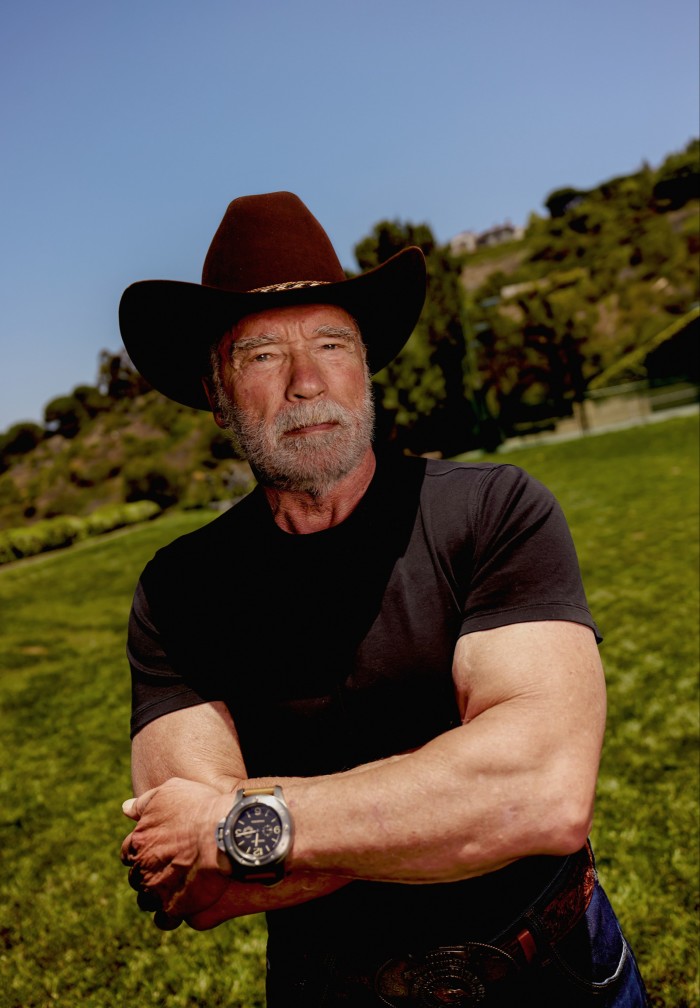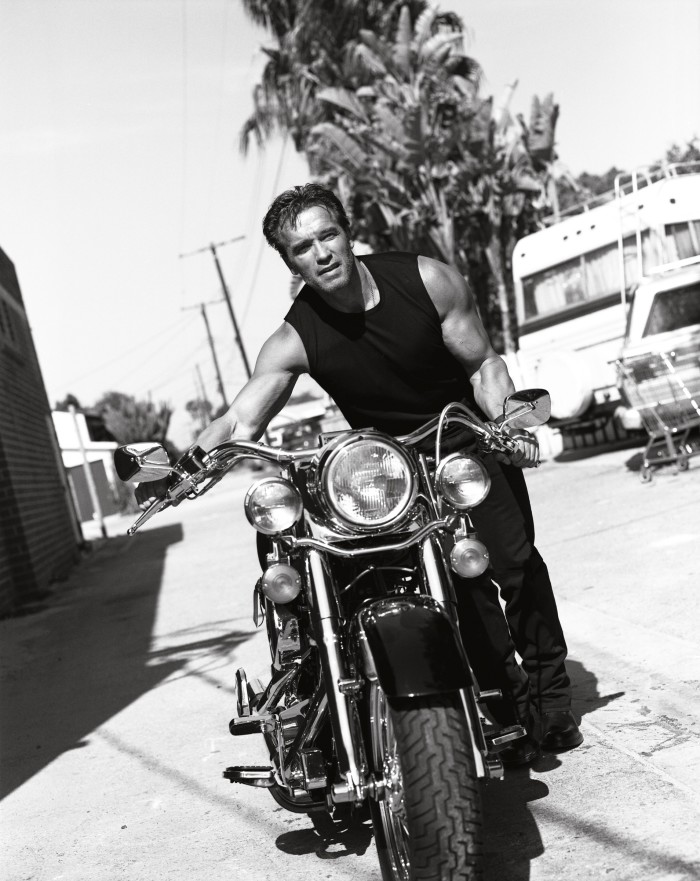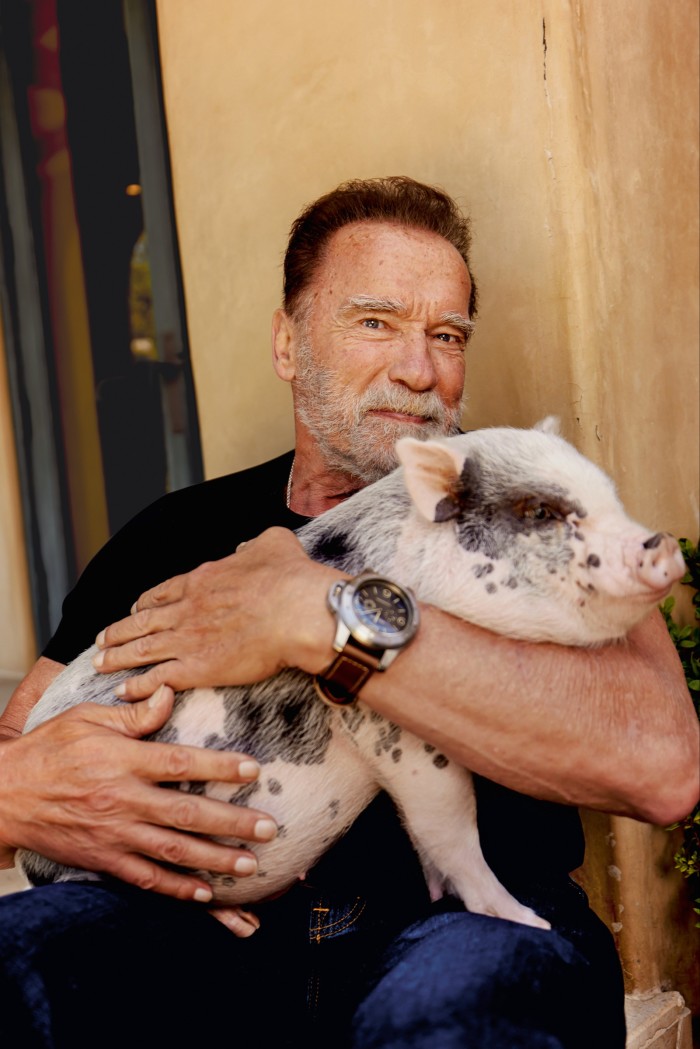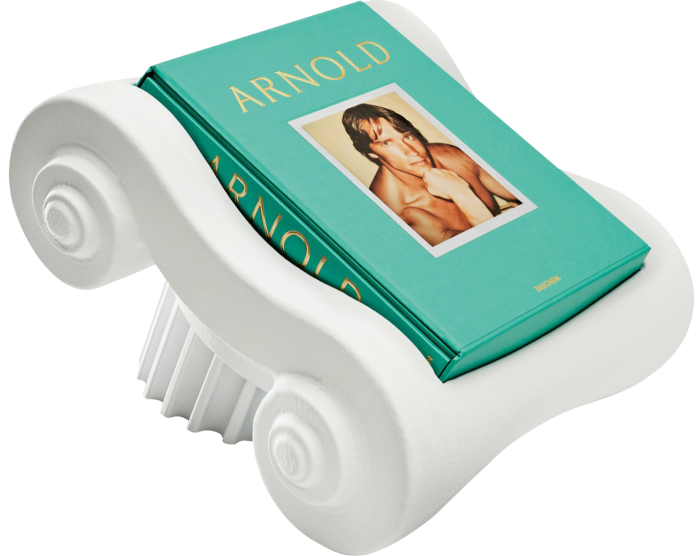Arnold Schwarzenegger: ‘I’m not the sort of person who looks back’

Simply sign up to the Film myFT Digest -- delivered directly to your inbox.
It’s close to 10am in LA and Arnold Schwarzenegger is eating a post-workout breakfast of oatmeal and hardboiled eggs in his house, leaving me alone on the covered outdoor patio where we are due to have our interview. It feels like a tacit invitation to explore the grounds of Schwarzenegger’s mansion in the city’s exclusive Brentwood neighbourhood.
My eyes fix – how could they not? – on the bronze sculpture of Schwarzenegger, frozen in one of his signature poses, that towers over his pool. Nearby is a bust of Abraham Lincoln, one of three statues of the great American president I have noticed since arriving. On a huge coffee table near an outdoor fireplace is a magazine featuring Schwarzenegger on the cover, alongside a well-thumbed script with handwritten notes, a wooden box of Cuban cigars and the guillotine he uses to trim them.
“Are you schnooping?” announces an unmistakable booming voice, as Schwarzenegger steps outside his house.
“Of course,” I reply, feeling about 65 per cent sure that he is joking. “You left a journalist alone.”
Schwarzenegger gives a little shrug and invites me to sit with him on the patio. He is wearing shorts, tall dark socks and a grey T-shirt. Those famous biceps are still large and well-defined – especially for a man who recently turned 76. And so is that jawline, though his skin bears evidence of years of flexing under the California sun.

I have been invited here to talk about Arnold, a giant, limited-edition, pictorial retrospective of his career that took a decade for its publisher, Taschen, to curate. It is massive – 334 pages plus a 556-page companion volume – and features portraits by Richard Avedon, Annie Leibovitz, Robert Mapplethorpe, Herb Ritts and Andy Warhol, among others, alongside interviews and essays (1,947 signed copies, from £1,250; 850 sit on a Capitello book stand, £2,500; and 100 include a ChromaLuxe print signed by Leibovitz, at £12,500).
“Did you get a copy of the book?” he asks me. A large box containing the very heavy book has been delivered. “It took two of us to get it up the stairs and into the house,” I tell him.
“Oh, poor baby,” he deadpans. It’s pure Schwarzenegger: droll, teasing, intimate.
The book arrives as Schwarzenegger is having a late-career revival. He has two new shows on Netflix: Fubar, an action comedy about a CIA agent who comes out of retirement to work alongside his daughter, and Arnold, a three-part documentary about his life. Later this year – strikes pending – he will begin filming an action thriller called Breakout, his first movie in four years. He also writes a daily newsletter for more than 500,000 subscribers. After over 50 years in the public eye, Schwarzenegger still has a “global fan base that spans generations”, says Bela Bajaria, Netflix’s chief content officer. “He hasn’t taken anything for granted and he believes in doing the work.”
The past, though, isn’t territory Schwarzenegger is especially happy to revisit. He “hated every minute” of the interviews for the Netflix documentary, which took between 30 and 40 hours to film. “I just find [looking forward] more inspiring and motivating than looking in the past,” he says.

Nevertheless, his journey from bodybuilding teen to gubernatorial leader remains no less intriguing, and sometimes controversial. The documentary sees him speak openly about his disciplinarian father, growing up in post-war rural Austria and his intense desire to leave the country. He brightens as he talks about arriving in California in 1968 at the invitation of Joe Weider, the publisher of the American bodybuilding magazines that had inspired him back in Austria, and about the new life he discovered at Gold’s Gym, Venice Beach, the cathedral of iron-pumping (and where he still works out today). But the doc also sees him address his personal failings, including the groping accusations that emerged during his 2003 campaign for California governor – “Forget all the excuses, it was wrong” – and the painful end to his 25-year marriage to Maria Shriver, which dissolved after she discovered he had fathered a child with long-time housekeeper Mildred Patricia Baena.
“Together, the book and Netflix documentary were meant to address the question of ‘how do we celebrate my life?’” he tells me. “Which is complicated… There’s just so much there [in my life] that I’m not so aware of because I’m not the sort of person who looks back.”

Thankfully perhaps for him, we are shortly interrupted by his nine-month-old pet pig, Schnelly, who appears to have a chunk of lawn hanging out of his mouth. He is the newest of Schwarzenegger’s pets, which include a miniature pony, a donkey and three very friendly dogs. We are then joined by Heather Milligan, Schwarzenegger’s partner of a decade, who owns a physical-therapy practice in LA. Schwarzenegger introduces us, and then she directs her attention to Schnelly. “C’mon, let’s go!” she says, with some authority. The pig offers little resistance and trots off.
Picking back up, I wonder if it has felt therapeutic to talk about his life. “No – nothing therapeutic. It was kind of, like, torturous, you know?” he says. “To create a future is creative. It’s not creative to repaint the canvas of the past.”
The line makes him think of Warhol, whose Polaroids of Schwarzenegger feature in the new book. The memory of visiting Warhol’s Factory in 1977 seems to lift his whole demeanour. “I was at the Factory,” he begins, now puffing on a Cuban. “I was painted by Jamie Wyeth. He painted [ballet star Rudolf] Nureyev in the morning and he painted me in the afternoon. It went on for two weeks.” Schwarzenegger later commissioned Warhol to do a portrait of Shriver, which he gave to her as a wedding present.
Schwarzenegger has clearly been thinking a lot about the pop artist. Though he has few obvious similarities to Warhol, Schwarzenegger shares the artist’s instinctive grasp of the power and utility of fame, and flair for self-invention. “Warhol separated himself from other artists by working with what he called his most important art, which was himself,” Schwarzenegger says. “He created himself.”

When Schwarzenegger arrived in California, he understood that becoming the world’s biggest bodybuilder wasn’t just about building the world’s biggest body. He also had to make the sport itself bigger. “We were trying very hard to sell the idea of weight training – muscles – to the world,” he says. “So we had to work very hard in figuring out how to do that.”
Schwarzenegger says he learnt the art of salesmanship as a teenage apprentice in a hardware store back in Thal, Austria; skills that proved useful when talking to the media. Most of his fellow bodybuilders avoided the mainstream press because the reporters seemed hostile, he says. “When their editors sent journalists to the bodybuilding competitions and no one spoke to them, they just wrote what they saw: a bunch of oily bodies up there, you know, posing.” So Schwarzenegger hired a publicist – he says he was the first bodybuilder to do so – to help improve his own image and reframe how people saw the sport. He wasn’t posing in the mirror because he was a narcissist, he told the press, but because he wanted to do his exercises correctly. Before long, a major newspaper was proclaiming him the “Babe Ruth of Bodybuilding” after the legendary American baseball player.
“It created this whole phenomenon of people running to the gym and wanting to build up their body,” says Schwarzenegger. “Then all of a sudden on TV, you saw more muscular guys, and more muscular guys in the movies, and then action movies.”
The lesson he learnt was that he could sell anything with the right message and strategy – whether his latest movie, his political candidacy or a favoured environmental policy. “If you find the right way of communicating, you can unlock something that is almost impossible to do.”
Although Schwarzenegger had longed to live in America, he was initially disappointed by the state that he would later run for eight years. “You drive down to Gold’s Gym in Venice, and I was like: why are they not sweeping the sidewalks?” he says. “It’s outrageous that they aren’t cleaning the sidewalks! You know, in Austria, everything is clean. Why are there all these little houses? I thought there were high-rises in America. I imagined big, tall buildings like in Rio de Janeiro. And then they showed me Hollywood, and that was a huge disappointment!”
Portraits of him from those early Venice Beach days show a young man bursting with confidence and charisma. These traits – along with a strategic mind and a brutal competitive instinct – are best captured in the 1977 docudrama Pumping Iron, about the world of professional bodybuilding. The film was a hit in international film circles and stimulated a huge interest in bodybuilding – and in Schwarzenegger himself. “Without Pumping Iron I would not have been successful,” he says.
As is the case with many transplants to LA, Schwarzenegger eventually warmed to the city. “Within a year I finally figured it out,” he says. “What was most impressive was how open-minded the Americans were, how positive they were, how they opened up their arms to me.”

Dian Hanson, editor of the Taschen book, met him in 1981 while covering the Mr Olympia bodybuilding contest. She immediately sensed star quality. “He was just so charismatic,” she says. “If he had just been this brilliant, ruthless competitor [in bodybuilding], using his looks and his great body to succeed, he would have been a great character. But he’s so much more complex than that.”
It took a while longer for Hollywood to call. His accent was too strong, his body was too large. Schwarzenegger notes that popular actors of the 1970s – Al Pacino, Dustin Hoffman, Woody Allen – were not big men. Nobody wanted to cast a man like him. “People were turning me down,” he recalls. “But I just saw it so clearly that my time would come. And sure enough, it came.”

His big break into feature films came in 1982, when director John Milius cast him in Conan the Barbarian. Not long after, director James Cameron would prove that even Schwarzenegger’s thick Austrian accent could also be a bankable commodity, in The Terminator, even though OJ Simpson was initially suggested for the title role. Schwarzenegger recalls with a laugh: “My accent was perfect. Jim Cameron said: ‘You talk differently than we all do – you talk like a machine! This is what makes Terminator.’” It was inspired casting. Would the line “I’ll be back” have become an enduring catchphrase if it had been delivered by anyone else?
Schwarzenegger’s fame soared. He released nine more films before reprising the role in Terminator 2: Judgment Day in 1991, earning $520mn worldwide. It remains his highest-grossing film. He continued to make blockbusters, alongside unexpected comedies, for the rest of the decade. But by the early 2000s his career was moving – into politics – and taking a new shape.
Later on the day we meet, Schwarzenegger appears at an event at the Academy Museum of Motion Pictures, where he is in conversation with Hanson. As I sit waiting for the programme, I overhear some British fans talking excitedly about why they love Schwarzenegger so much.
Schwarzenegger was the ultimate example of the American immigrant success story, says one. And they are right. A young Austrian arrives in America, becomes an international bodybuilding star, breaks into Hollywood with little English and no obvious aptitude for acting, conquers the box office and becomes governor of America’s most populous state. If it were a Hollywood pitch, it would be rejected for being too far-fetched.

For even as he was conquering Hollywood, Schwarzenegger – who idolised the actor-turned-president Ronald Reagan – was harbouring other ambitions. He joined America’s most famous political dynasty in 1986 when he married Shriver, the niece of John, Bobby and Teddy Kennedy, with whom he had four children. He tells me his interest in politics was piqued as he listened to his in-laws talking around the dinner table. But Hanson believes his political ambitions were formed long before most Americans had even heard of Schwarzenegger.
According to her, the actor was dreaming of becoming president of the United States as early as 1973. “That was always his goal. He was going straight to the top from the very beginning.” Schwarzenegger saw his chance to emulate Reagan – who served as governor of California between 1967 and 1975 – during a movement to recall Gray Davis from the job in 2003.
Given her family’s tragic history, Shriver did not initially relish the idea of her husband running for California governor. But she eventually acquiesced, and Schwarzenegger announced his candidacy during a guest appearance on comedian Jay Leno’s late-night show.

Schwarzenegger left office as California governor in 2011, after serving for eight years. Though a committed Republican, some of his policies were to the left of his party’s, particularly on abortion rights and the environment. He was praised by Democrats, including Barack Obama, for championing green-energy infrastructure and cracking down on tailpipe emissions. Since he has been out of office, the divide between Schwarzenegger’s brand of Left Coast conservatism and the Trump-era party only appears to have grown.
Today, he expresses frustration at the turn in the party since Trump took control. Schwarzenegger has made savvy use of social media to keep his views out there, releasing a video on Twitter in which he decried disinformation and called Trump “the worst president ever” after the 6 January riots in the US Capitol Building. In another, he condemned Russia’s invasion of Ukraine – when some Republicans, including Trump and Florida governor Ron DeSantis (who is running second in the polls for the party’s nomination), left doubts about whether they believed the US should be involved in the conflict.

As a foreign-born citizen, Schwarzenegger is forbidden by the US Constitution from running for the White House. That said, he thinks he could win next year if allowed to run. “The field is open right now,” he told CNN recently, without naming Trump or DeSantis. “It’s a no-brainer.”
When I ask Schwarzenegger how he would win, he is all politician. “First of all, my message has nothing to do with running or not running,” he says. “My message today is that we have to come together as a country. If we all look at America as a place that we want to be number one in the world, then we have to play ball together. And we will be much more successful.” Without naming Trump, he decries name-calling and wants to see a return to civility in politics. He talks about old Republican themes like lower taxes and reduced government spending.
Of Schwarzenegger’s chances, Dan Schnur, a veteran political analyst and professor at the University of Southern California, says: “There’s a sizeable audience for the ideological message that he’s selling, maybe more now than 20 years ago.” Even if he could be a viable candidate, Schwarzenegger would face structural obstacles getting through the Republican primaries, but Schnur adds: “He has spent his entire career disproving conventional wisdom.”
Sitting on his patio near a crackling fire in a large stone fireplace, Schwarzenegger dismisses further speculation: “I don’t think about it. Why waste time on it? I’m not going to complain about not having the one job that I can’t do.” For a man who has spent his lifetime triumphing against the odds and “communicating [to] unlock… the impossible”, I’m not entirely convinced that, even at 76, his ambitions are so easily tamed.
The interview and photoshoot were conducted before the American actors’ union SAG-AFTRA’s strike began on 14 July


Comments